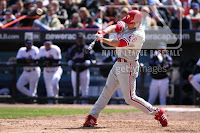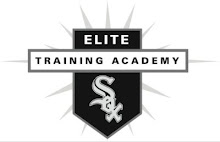At the Academy, we teach the hands to work “on-line” to the baseball. While knowing that the hands do follow a slightly curved arc in their path to the ball, we use this cue in attempt to keep the hitters barrel in the zone as long as possible. If you follow the illustration below from right to left, I will explain the hand path from start to finish. At toe touch the hands are in their launch position, they will be beyond the back shoulder and slightly behind the body line (due to the scapular load). As the front heel drops, rotation begins, clearing a path for the hands to work “on line to the baseball.” It is during this rotational part of the swing that you see the hand path on a curved line (illustrated by the first four baseballs in the picture, from right to left). During this portion of the swing the hitters back elbow will slot, just inside the body (close to the rib cage). As the hips complete rotation, the hands continue “on line” through the baseball until extension. Slightly prior to extension, the hands will finish their slightly curved arc as the hands roll over and follow through.
We teach the “on line” swing to keep the bat in the hitting zone for as long as possible. The longer the hitter stays in the zone, the better the chance for solid contact. The bigger the zone we hit in, the less perfect the timing portion of the swing has to become. Since the timing portion of the swing is the most difficult, keeping the bat in the zone is a big benefit. Hitters that fail to do this, mainly do so for two reasons. First they take their hands away from their body initially, causing a larger curved arc and decreasing the time the bat is in the zone. Or two, hitter cut their swing off early (off their front hip) prior to getting to extension. Both cases, limit the time the ball is in the zone, diminishing the area to have solid contact and making the timing of the swing even tougher.
Below is an illustration in Robert Adair’s book The Physics of Baseball which shows proper bat path.











